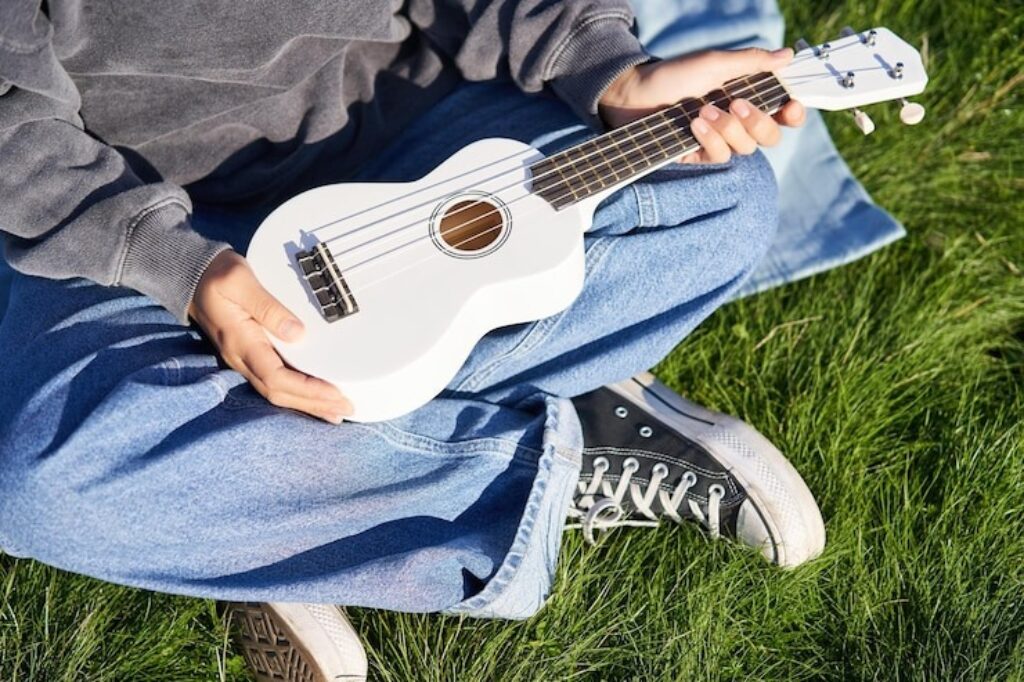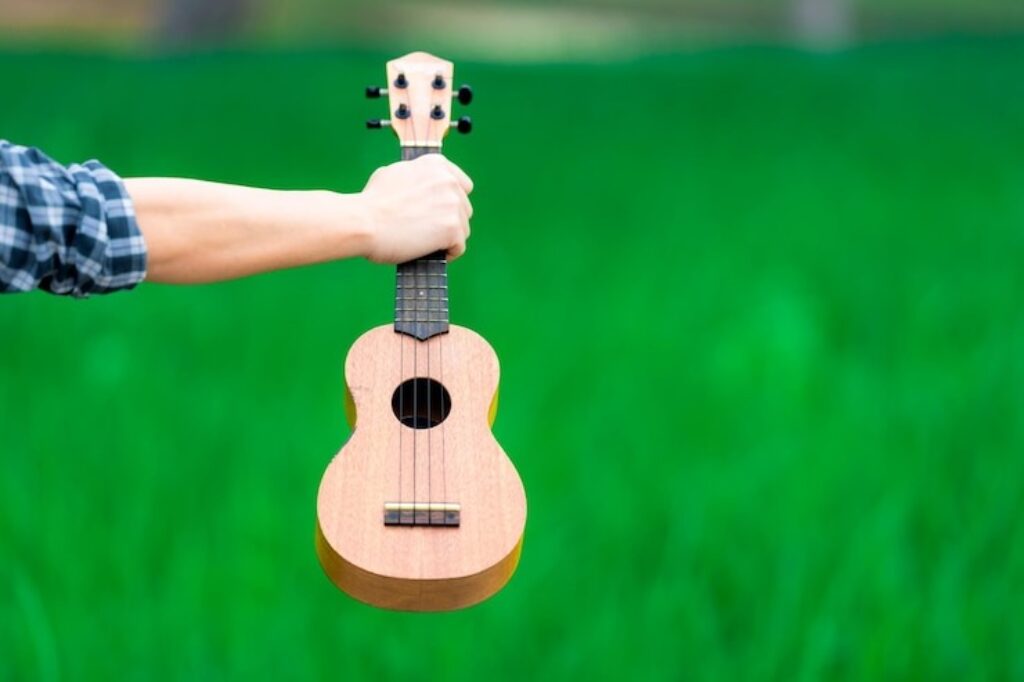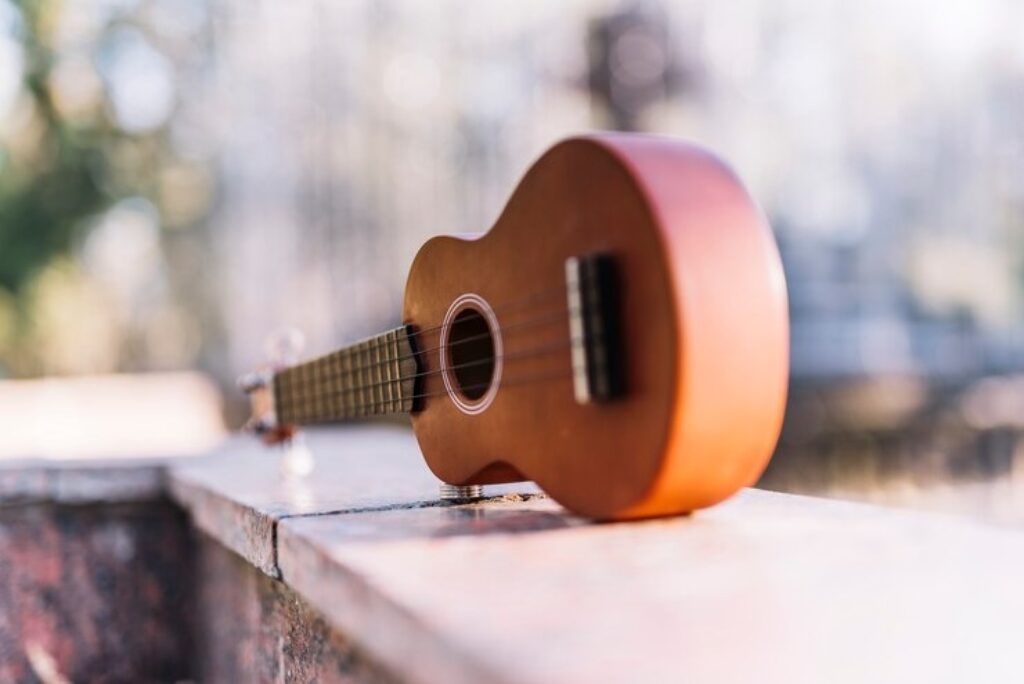
The ukulele, with its cheerful sound and portability, has become a beloved instrument for musicians worldwide.
Whether you’re strumming simple ukulele chords by the beach or performing on stage, the ukulele offers a unique musical experience.
However, when it comes to choosing between an electric ukulele and an acoustic ukulele, many find themselves at a crossroads. This guide aims to explore the nuances of both, helping you make an informed decision on which suits your musical journey best.
Table of Contents
What Is an Acoustic-electric Ukulele?

Source: freepik.com
An acoustic-electric ukulele, often just called an electric ukulele, combines the traditional acoustic design with electronic components, allowing it to be plugged into an amplifier.
This hybrid offers the best of both worlds: the warm, unplugged sound of an acoustic ukulele for intimate settings and the amplified option for larger audiences or recording purposes.
The electric component typically involves a pickup and preamp system, which captures the vibrations of the strings and converts them into electrical signals.
The preamp then allows for volume control and, in some models, tone shaping through equalization settings, making it versatile for various musical styles.
When Do I Not Need an Acoustic-electric Ukulele?
While the acoustic-electric ukulele is versatile, it’s not necessary for everyone. If you primarily play in small, quiet settings where amplification is not required, a traditional acoustic ukulele might be more appropriate.
Additionally, if you’re a beginner focused on mastering ukulele chords and strumming patterns, the simplicity of an acoustic ukulele could be more beneficial. It allows you to focus on technique without the added complexity of electronic components.
Also, for those who prefer the authentic, unplugged sound and do not plan to perform in large venues, an acoustic ukulele preserves the instrument’s traditional essence without the need for electronic enhancement.
What Acoustic-electric Ukulele Should I Buy?

Source: freepik.com
Choosing an acoustic-electric ukulele depends on several factors, including budget, playing style, and personal preferences. Here are a few considerations:
Pickup and Preamp Quality
When delving into the specifics of pickup and preamp quality in acoustic-electric ukuleles, it’s essential to understand that the pickup is the heart of the electric element.
A piezo pickup, commonly used in these instruments, translates the vibrations of the ukulele strings into electrical signals without needing external microphones.
This technology is favored for its ability to produce a sound that’s true to the acoustic nature of the instrument.
However, not all pickups are created equal. High-quality pickups will ensure that the sound transmitted to the amplifier is as close to the natural acoustic sound as possible, without the harshness or brittleness that lower-quality pickups might introduce.
The preamp, on the other hand, is responsible for boosting the signal from the pickup and often includes tone shaping controls such as bass, mid, and treble, as well as volume.
The quality of the preamp significantly affects the amplified sound’s fidelity and versatility. Investing in a ukulele with a high-quality preamp and pickup system will allow for a wider range of sound adjustments, ensuring that you can tailor your sound to suit any venue or playing style.
Wood Type

Source: freepik.com
The choice of wood in an acoustic-electric ukulele not only influences its acoustic tone but also how the instrument’s sound is projected and amplified. Mahogany is known for its warmth and richness, providing a mellow, rounded sound that’s perfect for traditional ukulele songs.
Koa, native to Hawaii, has a brighter and more pronounced midrange, reflecting the classic ukulele sound associated with Hawaiian music.
Spruce, often used for the top of the ukulele, offers excellent clarity and volume, making it ideal for players who seek a more pronounced sound projection.
The density and resonating qualities of these woods play a crucial role in how the instrument’s sound is amplified. A denser wood like koa can produce a louder, clearer sound when plugged in, while mahogany tends to maintain its warmth and richness, even through an amplifier.
The choice of wood can also affect the instrument’s durability and aesthetics, with each wood type offering a unique grain pattern and coloration, adding to the ukulele’s visual appeal.
Size

Source: freepik.com
The size of the ukulele significantly influences its playability and tonal characteristics. Soprano ukuleles, the smallest size, are famed for their bright, punchy sound, which is quintessentially ukulele.
Concert ukuleles offer a slightly larger body, resulting in a fuller sound with more midrange depth, making them a versatile choice for both beginners and experienced players.
Tenor ukuleles provide an even richer tone and increased volume, due to their larger size, making them well-suited for acoustic-electric models where the nuance of the instrument’s tone is crucial when amplified.
Baritone ukuleles, the largest size, offer a deeper, more guitar-like tone, which can be an exciting option for those looking to bridge the gap between guitars and ukuleles.
The size of the ukulele not only affects its sound but also its playability; smaller sizes are more suited to players with smaller hands or those seeking a traditional ukulele sound, while larger sizes offer a more comfortable playing experience for those with larger hands or those seeking more volume and tonal depth.
Brand and Budget
Navigating through brands and budget considerations is a critical step in selecting the right acoustic-electric ukulele. Renowned brands often guarantee a level of quality and reliability, with established reputations built on craftsmanship and sound quality.
However, this doesn’t mean that less expensive or lesser-known brands can’t offer excellent instruments. The key is to look for brands that provide the best value for your budget, considering both the quality of construction and the quality of the sound.
In recent years, many brands have emerged that specialize in producing high-quality ukuleles at affordable prices, making it easier for beginners and seasoned players alike to find an instrument that meets their needs without breaking the bank.
Reviews, forums, and user feedback can be invaluable resources in identifying the best instruments in various price ranges.
Features

Source: freepik.com
Modern acoustic-electric ukuleles come equipped with a range of features designed to enhance the playing experience. Built-in tuners are a convenience that cannot be overstated, allowing for quick and accurate tuning without the need for an external device.
EQ controls are crucial for shaping the amplified sound, enabling players to adjust the bass, mid, and treble frequencies to suit their playing style and the acoustics of the performance space.
Feedback reduction is another important feature, particularly for live performances, where the risk of feedback can be high. Some ukuleles come equipped with feedback suppressors or phase switches that can minimize this issue.
Conclusion
The choice between an electric ukulele and an acoustic ukulele boils down to personal needs and preferences. If you desire the flexibility to perform across various venues and record with ease, an acoustic-electric ukulele is a versatile choice that can broaden your musical horizons.
However, for those who cherish simplicity and the authentic sound of strumming ukulele chords in a quiet setting, the acoustic ukulele remains a timeless option.
Regardless of your choice, the ukulele promises a world of joy and creativity.





